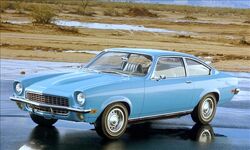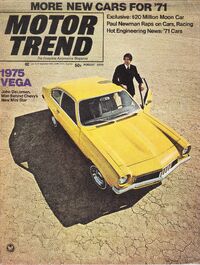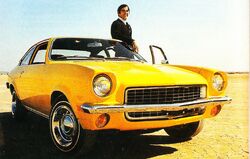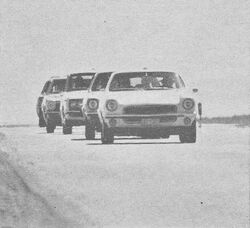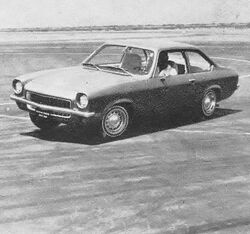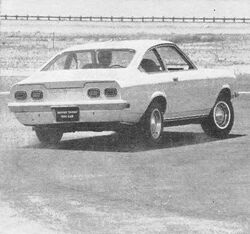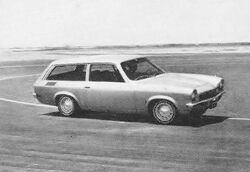The Chevrolet Vega is a subcompact automobile produced by the Chevrolet division of General Motors for the 1971 to 1977 model years. Introduced September 10, 1970 as the Vega 2300, it's name is from a bright star in the northern skies and the engine's approximate displacement in cubic centimeters.
Designed from scratch by a team of fifty GM corporate engineers assigned exclusively to the program, the Vega was available in four models: a notchback sedan, a hatchback coupe, a station wagon, and a panel delivery (thru 1975). All have two doors and hold four passengers, except the panel delivery which is designed for one passenger. The Vega engine is a 140 CID (139.6 cu in) aluminum-block OHC inline-4.
The Vega competed directly with its domestic rivals from Ford and AMC and imports from Toyota and Datsun as well as the rear-engine VW Beetle. Conservative estimates had placed the cost of bringing the Vega from drawing board to production reality at a staggering $200 million (equivalent to $1.7 billion in 2024) compared to 6 million for the AMC Gremlin. The car's introduction was overseen by Chevrolet general manager John Z. DeLorean.
Motor Trend awarded the Vega 1971 "Car of the Year" after a 4-day ride and drive that saw ten of Detroit's finest put through a 1,000 mile wringer. Car and Driver readers voted the Vega "Best Economy Sedan" 1971, 1972 and 1973 in the C&D Annual Reader's Choice Poll, unseating the incumbent import's eight year winning streak.
The Vega's 140 CID engine cooling issues were addressed early on with a revised cylinder head gasket, a coolant recovery system and low coolant warning light. By 1972, the car had established a good reputation with the public with reliability in the division exceeded only by the compact Nova. The one-millionth Vega, a bright orange GT hatchback was produced May 17, 1973. A special limited edition of 6,500 were built to commemorate the milestone. The Vega was among the top 10 best-selling American cars by 1974 with a model-year sales peak of 460,374.
The Cosworth Twin-Cam, a limited production, performance model was introduced in March 1975 featuring a 122 CID (121.7 cu in) all-aluminum inline-4, the 16-valve, DOHC cylinder head design by Cosworth Engineering in England with Chevrolet's first use of electronic fuel injection developed for the engine by Bendix Corporation.
5,000 engines were hand built at GM Tonawanda and 3,508 consecutively numbered 1975-76 Cosworth Vegas were produced at Lordstown Assembly over seventeen months.
Vega sales in 1975 were less than half the previous year resulting from the end of the gas crisis with less demand for all small cars. The Vega's 140 CID engine, body and chassis received six years of refinements with three hundred new part numbers in 1976 alone, more than any other Chevrolet that year. Despite the continuous development program and over two million built outselling VW's entire passenger car lineup, production of the Vega and the aluminum four-cylinder engine ended July 1977 with the rebadged Pontiac Astre in a consolidation of the H-body platform. The Vega hatchback reappeared as a rebadged 1978 Chevrolet Monza 'S' and the Vega wagon rebadged 1978-79 Monza and Pontiac Sunbird wagons. Production of the newer Vega-derived Monza 2+2 hatchback and coupe ended in 1980 with variants Pontiac Sunbird, Oldsmobile Starfire and Buick Skyhawk.
History
Origin
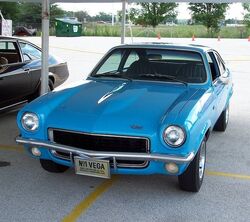
No. 1 Vega built, June 26, 1970
photographed in 2005
Chevrolet and Pontiac divisions were working separately on small cars in the early and mid 1960s. Ed Cole, GM's executive vice-president of operating staffs was working on his own small-car project using the corporate engineering and design staffs. He presented the program to GM's president in 1967. When the corporation started seriously talking about a U.S. built mini-car, Cole's version was chosen with the proposals from Chevy and Pontiac rejected, and Cole's new mini-car was given to Chevrolet to sell. Not only did corporate management make the decision to enter the mini-car market, it also decided to develop the car itself. It was a corporate car, not a divisional one.
In 1968 GM chairman James Roche announced that General Motors would produce the new mini-car in the U.S. in two years. Ed Cole was the chief engineer and Bill Mitchell, the vice-president of the design staff, was the chief stylist. Cole wanted a world-beater, and he wanted it in showrooms in twenty-four months. This was a brutally short time to design and engineer a new car, especially one that borrowed almost nothing from any other. He formed a GM corporate design team exclusively for the Vega headed by James G. Musser, Jr. who had played major roles in helping develop the Chevy II, the Camaro, the 350 and 400 cu in V8s, and the Turbo Hydramatic transmission. Musser said, "This was the first vehicle where one person was in charge and, under him — that is me — a group of guys did the entire vehicle."
The Vega, like the Corvair, has long been referred to as Ed Cole's baby. It was as GM president that Cole oversaw the genesis of the Chevrolet Vega. Early spy reports called the Vega "Gemini" and "GMini," although Motor Trend and other publications used the correct internal designation, XP-887. Chevrolet "teaser" ads began in May 1970, not announcing its name, stating -You'll see.
Development 1968–1970
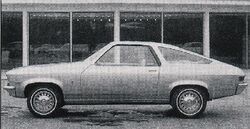
XP-887 Hatchback Coupe clay model
GM studio, September 1968
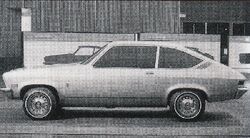
XP-887 Hatchback Coupe clay model
GM studio, late September 1968
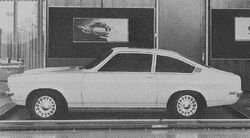
XP-887 Hatchback Coupe clay model
Chevy studio final design, 1969
The Chevy Vega was conceived in 1968 as a simple, low-cost transportation vehicle to utilize the newly-developed all-aluminum die-cast engine block technology. The first sand cast aluminum blocks were actually produced a full two years prior to the corporate decision to build the Vega. A relatively large displacement engine with good low speed torque was chosen. Economy would be achieved through the use of low numerical gear ratios, which would keep engine rpm low. The Vega engine itself went through 6,000,000 driving miles of testing. The earliest version of the engine was tested in a Fiat 124 sedan. This car was used for development of the aluminum block, while several 1968 Opel sedans were used for drive train development.
General Motors instituted a totally new management program to design the Vega: the car line management technique. In placing a single individual, the chief vehicle engineer in charge of the entire program and having the entire car – including engine, suspension, and brakes – designed by engineers specifically assigned to the Vega. A total of fifty engineers were assigned to the Vega engineering team broken down into body, power train, and chassis design groups, the product assurance group, and the pleasability group. Fisher Body engineers and draftsmen were also moved in with the Vega personnel. It is generally acknowledged that this organizational arrangement made it possible to put out a totally new car in such a short time. The pleasabilty group would check continuously on the vehicles on the assembly line. As part of another program, computers would keep tabs on quality control of every vehicle built.
At the very beginning of the experimental engine program at GM engineering staff, Ed Cole stated in a meeting that there would probably be no need for a traditional radiator, due to the excellent heat rejection to the air from the aluminum block. He felt that coolant could simply be passed through the heater core, with outside air ducted through the core and exhausted under the car to provide auxiliary cooling. Several pre-prototype cars were built this way at his insistence, and all of them were dismal failures from a cooling perspective. After having one seize up while he was driving it at the Milford proving grounds one Saturday, he backed away from his theory and allowed the design to continue with a conventional cooling system.
- January, 1968 – Ed Cole visited GM Styling to review XP-887 Program. He requested provisions for V8 engine, a full-line of body styles and consideration of a two-passenger coupe version.
- August, 1968 – XP-887 Dummy clay models complete, Surface scans and digital tapes released to Fisher Body R&D Department for purpose of building prototype bodies for coupe, sedan and station wagon.
- October 1968, there was only one body style – the "11" style notchback sedan, one engine, one transmission – the MB1 Torque-Drive manually-shifted two-speed automatic, no headliner, one base trim level, a bench seat, molded rubber floor covering, no glove box, no air-conditioning option, ventilation only through the upper dash direct from the wiper plenum, and exterior paint on the interior. As the program progressed into development, the market changed, and so did the product:
- December, 1968 – Hatchback, wagon, and panel delivery styles added. floor-level ventilation added. optional performance engine ("L-11" two-barrel) added; predicted production rate was 20%; actually ran at 75%. Bucket seats replaced bench seat as standard equipment. Carpeting and headliners added for hatchback and station wagon. Air Conditioning option added; predicted production was 10%, actually ran at 45%.
- February, 1969 – Opel three- and four-speed transmissions added (three-speed standard, others optional), Powerglide added (now four transmissions), mechanical fuel pump replaced by in-tank electric fuel pump, power steering option added, base "11" style Notchback trim upgraded to match Hatchback and Wagon (carpet and headliner).
- April, 1969 – Gauge-pack cluster option added, HD suspension and wide tire option added, adjustable seat back option added; ran at 45% production, bumpers restyled, lower valance panels added, swing-out quarter window option added; ran at 10% production.
- July, 1969 – Electrically-heated backlite option added; ran at 10% production, "GT" package option added at $325.00; ran at 35% production, bright window-frame and roof drip moldings added to the Hatchback and Wagon. This is essentially how the car launched as a 1971 model.
Production began on June 26, 1970. After the National GM strike (9/70-11/70) ended, bright roof drip moldings were added to base "11" notchback; moldings were sent to dealers to update units already in the field in December. The car still had no glove box.
Models
Motor Trend '71 Buyers Guide said, " Engineering and styling the Vega from scratch in four different body styles was a total effort far more demanding in manpower than the Pinto or Gremlin programs." "Vegas, in summary, are a striking quartet."
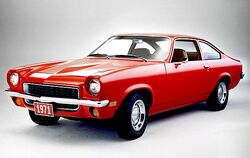
1971 Vega Hatchback Coupe
The Hatchback Coupe, first and foremost, is a styled subcompact. With its lower roof line and useful fold-down rear seat, it accounted for nearly half of all Vegas sold.
Road & Track, September 1970 said, "Will the real Ferrari 365 GT 2+2 please stand up? Vega coupe has roof, window, and deck forms extremely-and not accidentally-similar to those of the Italian luxury car."
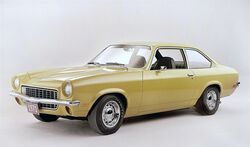
1971 Vega Sedan
The Sedan, later named Notchback is the only Vega model with an enclosed trunk, has more rear seat headroom than the hatchback, and offered the lowest base price."
Road & Track, November 1970 said, "The plain Vega sedan is as good-looking a car as you'll find in its class...with the Vega they've turned out one of the finest-looking compact sedans in the world." -
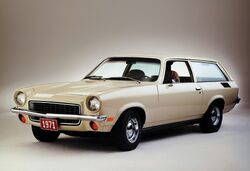
1971 Vega Kammback Wagon
The Kammback Wagon has 50.2 cubic feet of cargo space (with the rear seat down), a lower cargo lift over height and a swing-up liftgate; retains the coupe's handling capabilities.
Road & Track, September 1970 said, "Vega wagon has extremely simple but pleasant overall shape, angular but well balanced." "...the wagon is VW-like in its simplicity."
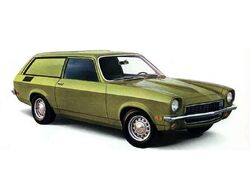
1971 Vega Panel Express
The Panel Express, a one-passenger panel delivery based on the wagon has steel panels in place of the wagon's fixed rear side glass, a low-back driver's seat, and a deleted rear seat with an additional enclosed storage area under the load floor. An auxiliary front passenger seat was optional. Classified as a truck, the panel has 68 cubic feet of cargo space and a payload capacity of 650 lbs.
Road & Track, January 1972 said, "Officially, it's a truck. By us, it's a 2-place square-back Vega coupe, with room for just about everything and anything that two people would want to go anywhere with."
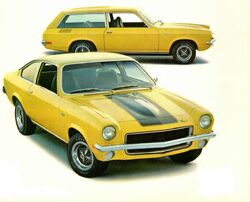
1971 Vega GT Hatchback Coupe &
Vega GT Kammback Wagon
In mid-1971 an optional GT package for Hatchback and Kammback models was introduced which included the L-11 two-barrel 140 engine, F-41 handling suspension, special instrumentation and sport steering wheel options, GT wheels, black grill with chrome outline moldings, GT emblems and more. Sport stripes in black or white were available.
Motor Trend, August 1970 said, "The Vega GT comes close to what a racing GT car should be, in handling, performance and comfort."
Dan Gurney, the first driver to win races in Formula One (1962), NASCAR (1963), and Indy Car (1967) combined put a Vega GT through its paces on a NASCAR oval. Gurney said: "I take off in the Vega and just gas it as hard as it will go right away and I go into a turn knowing that- a maybe I should feel it out first, but I, I have my pride or what ever it is, so I just went into the turn as hard as I could go right away and then I thought I'll find out what's gonna happen in the process, but-a as it turned out...it was effortless, the car. I like it; I like it very much. The depth of the engineering seems to shine through when you sort of, press it to see where the soft spots are. It's there, ready."
Design and Engineering
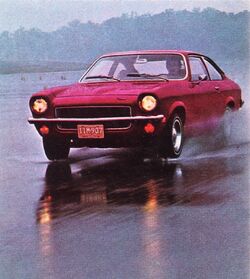
1972 Vega Hatchback Coupe
Motor Trend October, 1971
The Vega represented an entirely new direction for Chevrolet — a fuel-efficient, high-tech compact from the company best known for its full-size sedans and muscle cars. Everything about it was cutting-edge: it featured a lightweight aluminum engine block and sporty European suspension tuning, and the factory where it was built was the fastest and most automated in the world. GM even rolled out a brand new shipping method, Vert-A-Pac – hanging Vegas vertically in specially designed railroad freight cars. One of GM's proudest boasts about the Vega was that it was the most "automated" vehicle ever to be built. It's entire design hinged upon its ability to be built rapidly with as much machine labor (instead of human) as possible. This was the only way GM could sell the car at a price competitive with imported cars made with cheaper labor rates.
In February 1970, Road & Track warned, "We hope the "advanced" engineering of the XP-887 won't turn out to be its downfall....Assembly quality has a lot to do with the VW's success too, and this more than anything else is the bane of today's American car." Prophetic words indeed.
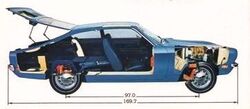
Vega wheelbase & length
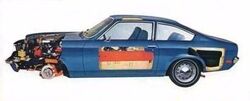
Vega cutaways show space utilization, safety door beams & double paneled roof
All Vega models have a 97.0-inch wheelbase and a 65.4-inch width. The 1971–1972 models have a 169.7-inch overall length or just over 14 feet. 1973 models are 3 inches longer due to the front 5 mph bumper. 1974–1977 models have front and rear 5-mph bumpers and are 5.7 inches longer than the 1971–1972 models. In a size comparison with a 1970 Nova, the Vega has a 14-inch shorter wheelbase, 7 inches narrower width, 2 inches lower height, and (1971–1972 models) have 20 inches less overall length.
As introduced, the Vega was one of the first Chevrolet vehicles to have as standard equipment front disc brakes, an electric fuel pump, side guard door beams, a double paneled roof, and foam-filled, hi-back bucket seats with floor mounted controls. Safety regulations and crash tests resulted in the Vega being nearly 300 lbs. heavier than the original goal. However, a part of the penalty was caused by the decision to use 35 lb of underbody compound on the top side of the floor stamping. The standard acoustical package added another 35 lbs. and when certain accessory and trim groups were ordered there was still more noise insulation.
The Vega's front-engine, rear-wheel drive layout is the traditional one where the engine is located at the front of the vehicle and driven wheels are located at the rear. The aluminum block inline-four engine was a joint effort from General Motors, Reynolds Metals, and Sealed Power Corp. The engine and its die-cast block technology was developed at GM engineering staff long before the program was handed-off to Chevrolet to finalize and bring to production.
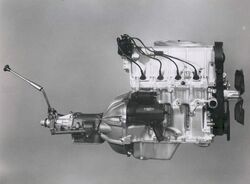
2300 cc (140 cu in) L4 engine,
3-speed manual
Ed Cole, who had been very personally involved with the design of the 1955 Chevrolet V8 as chief engineer at Chevrolet, was equally involved with the Vega engine as GM president, and was a frequent visitor on Saturdays to the engineering staff engine drafting room, reviewing the design and giving direction for changes. Chevrolet engineers and manufacturing personnel weren't pleased, especially since they knew Ed Cole wanted the job done quickly. As the engine development progressed at Chevrolet, it became known (in closed offices) as "The world's tallest, smallest engine" due to the tall cylinder head. Plagued by vibrations, noisy operation and prone to overheating, the engine did not live up to the Vega's potential. By 1974, the overheating and vibrations were a thing of the past and the noise had been reduced to an acceptable level.
GM's German subsidiary Opel was commissioned to tool up a new three-speed derivative of their production four-speed manual transmission. The GM finance department insisted that the base transmission be a low-cost three-speed, with the traditional profit-generating four-speed as an extra-cost option. Opel did just that, and tooled up a new 3-speed from scratch just for the Vega application, unusual only because it had shift linkages on both sides. Its final cost was higher than the optional four-speed due to the tooling investment and production volume. Both transmissions were shipped from Germany, 100 transmissions to a crate, and arrived in shipments of thousands of transmissions at a time. Initially Powerglide automatic and Torque-Drive semi-automatic transmissions were optional. The two-speed Torque-Drive required a manual upshift but had no clutch pedal. In 1973 the U.S.-built Saginaw three- and four-speed manual replaced the Opel-built manual transmissions, and the Turbo-Hydramatic had replaced the Torque-Drive and Powerglide. Axle ratios ran from a low 2.53 for economy, to a 2.92 for better acceleration with a slight fall-off in economy to a 3.36 performance ratio. Positraction was also available.
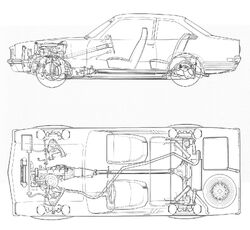
Vega component arrangement
Its suspension and live rear axle design, near ideal weight distribution, low center of gravity and neutral steering give the Vega world-class handling characteristics that were praised by the automotive press. Lateral acceleration capacity is .90g for the standard suspension, and .93g for the RPO F-41 suspension. Weight distribution is quoted at 53.2% front and 46.%8 rear. The overall chassis suspension was to be tuned to a new A78 × 13 tire that was being developed concurrently with the vehicle. The front suspension is classic General Motors short and long-arm. The lower control arm bushings were actually larger than those of the 1970 Camaro. The four-link rear suspension copied that of the 1970 Chevelle, and coil springs are used throughout. This was a significant departure from the leaf spring suspension used in the Camaro and Chevy II Nova. The engineers in charge of chassis development were seeking a package that would provide full-size domestic car ride qualities with handling equal to that of European cars. In 1976, a torque-arm rear suspension was adopted, replacing the four-link design, thus eliminating the panic-braking induced rear wheel-hop.
The steering box and linkage are located ahead of the front wheel centerline. The shaft is a cushioned two-piece unit. The overall ratio is 22.5:1 and the curb to curb turning circle is 33 feet. The Vega's front disc and rear drum brake system copied an excellent Opel design including 10-inch diameter single-piston solid rotors designed especially for the Vega and 9-inch diameter drum rear brakes, utilizing the leading-trailing design. The system is balanced to give braking distribution of 70/30 front and rear with no proportioning valve, and exhibiting nearly linear pedal effort.
All four Vega models share the same hood, fenders, floor pan, door lower panels, rocker panels, engine compartment, and front end. The roof panel is a double layer, with a drilled inner panel to cut noise. The hood is hinged at the front and features an inside locking mechanism. Due to its "Modular Construction Design", a Vega sedan with 578 body parts has 418 fewer parts than its full-size Chevrolet counterpart. Modular Construction Design reduced the number of joints and sealing operations resulting in stronger, tighter bodies, effectively contributed to vehicle quality and made possible a very high rate of production. The Vega's body surface was the first accomplished completely through use of computers. Body surface information recorded on tape derived from the clay styling model, allowed computers to improve the body surface mathematically. Tapes developed through the computer were also used to control drafting machines in producing master surface plates which were extremely accurate. The computer was also utilized in making the hundreds of necessary engineering calculations including vision angle, field of view, rear compartment lid and door counterbalance geometries, structural stresses, deflection calculations and tolerance studies.
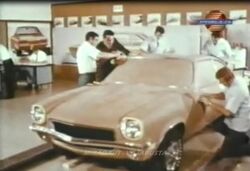
Vega clay model
The Vega's styling was judged conservative, clean-lined and timeless. The GM styling studio's main influence was the 1967–1969 Fiat 124 Sport Coupe AC. The coupe has hints of everything from Camaro to Ferrari in its styling. The Chevrolet Camaro/Corvette studio under Henry "Hank" Haga was doing the 1970 Camaro at the time. With direction from Bill Mitchell, Haga's group took a clay model and redid the engineering version of the Vega, grafting a miniaturized Camaro front end and egg-crate grille and capped the rear of the sedan and hatchback models with recognizable Chevrolet tail lamps.
The original approved clay model had small rectangular front parking lights below the bumper. One morning John DeLorean (GM Vice President and Chevrolet General Manager at the time) brought Zollie Frank, the owner of the world’s largest Chevrolet dealership (Z. Frank Chevrolet in Chicago) into the styling studio to show him the clay and get his thoughts on the design. He looked at the painted clay model, walked around it, then stood in front of it for a minute or so, and said: “Get rid of those wimpy-looking parking lights – they should be big, round things that look like European driving lights”. DeLorean turned to the studio chief, told him to make the change Zollie wanted, and said they’d be back to look at it later that afternoon. The modelers were put to work on large, round lamps and DeLorean and Zollie came back later that day and approved the change. DeLorean mentioned to the studio chief as they were leaving that “Zollie sells more Chevrolets than anyone else on earth – he knows what the customers like.” The car went to production exactly as it was revised that afternoon. The front end was redesigned three years later to cosmetically accommodate the larger (aluminum) 5-mph bumpers required for the revised 1974 pendulum bumper impact standard. The new front end featured a sloped, louvered grill, front valence with air intake below the bumper and recessed headlamp bezels.
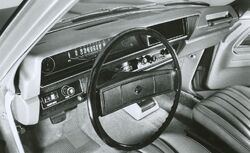
Vega custom interior trim
The seats are foam-padded and covered in vinyl with built-in head restraints (except delivery). Interior door panels are single-piece molded units. Flooring is rubber on sedan and panel delivery with carpeting and additional sound insulation added on the other two models. An optional Decor package for the sedan included the carpeting, the additional insulation, and a sliding adjustment for the passenger seat. A custom interior option for all models (except delivery) added upgraded upholstery, cargo area load floor carpeting in the hatchback and wagon, a two-position reclining driver's seat, passenger grab handle and woodgrain accents.
Many service operations were intentionally designed so that they were able to be performed by Vega owners. To further that end, a "Do-It-Yourself" service manual was included with each new Vega. This 112-page manual gives detailed information and guidance on eight different service and maintenance areas including lubrication, tune-up, brakes, and minor trouble shooting.
Model year changes
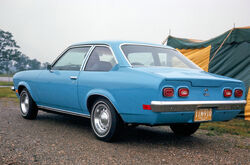
1971 Vega Sedan
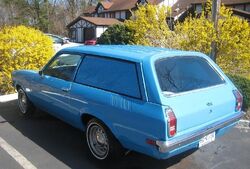
1971 Vega Panel Express
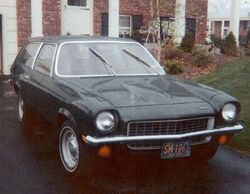
1972 Vega Kammback Wagon
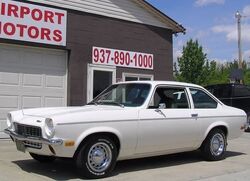
1972 Vega Sedan
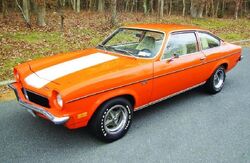
1973 Vega GT Hatchback Coupe
Millionth Vega limited special edition
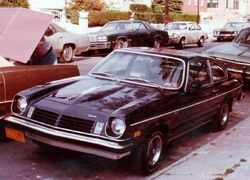
1974 Vega GT Hatchback Coupe
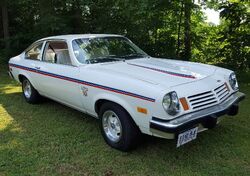
1974 Vega Hatchback Coupe
Spirit of America limited special edition
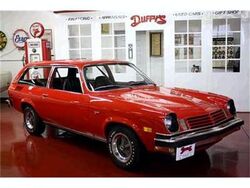
1974 Vega GT Kammback Wagon
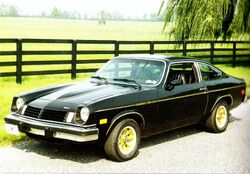
1975 Cosworth Vega Twin-Cam Hatchback Coupe
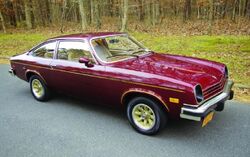
1976 Cosworth Vega Twin-Cam Hatchback Coupe
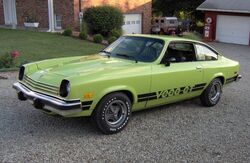
1977 Vega GT Hatchback Coupe
When first introduced, GM Board Chairman James Roche stated that there would be no major changes in the Vega for four years. Chevrolet ads also emphasized this continuity, but most of them mentioned five years. It was obvious right from the beginning that a new marketing concept was behind the Vega—a car not subject to annual model change for change's sake. Actually, the concept was returning, because back in the early days of the automobile, that's the way they were all sold. Imported automobiles were also not changed every year, and since the Vega was designed to battle the imports, it could be free from the curse of the annual model change. It also meant the styling had to be right the first time.
1971
In mid 1971 the GT option package was introduced, available for the Hatchback and Kammback included the L-11 engine, the F-41 suspension (H.D. springs and shock absorbers, front and rear stabilizer bars, 6-inch-wide wheels and 70-series raised white-letter tires), GT fender emblems, black-finished grill and lower body sills, clear parking lamp lenses, chrome belt and lower moldings, full instrumentation, four-spoke sport steering wheel, adjustable driver's seat back, passenger-assist handle and a wood-grain dash bezel. Satin-finished GT wheels with trim rings and chrome bow-tie center caps replaced the argent wheels and stainless hub caps, and a hood/deck sport stripe in black or white was optional.
1972
1972 models were essentially carried over from 1971 with a few refinements and additions. A three-speed Turbo-hydramatic automatic transmission option was added mid-year, joining the two-speed Powerglide. The Torque-Drive transmission was discontinued. Only 7,835 Vegas had been ordered with the semi-automatic and it was dropped at the end of the 1971 model year. Vibration and noise levels were reduced by a revised exhaust system and better driveline damping and the rear shock absorbers were revised. A custom cloth interior option was new and a glove box was added.
1973
The 1973 Vega had over 300 changes, including eight new exterior colors, four of them exclusive to Vega, new interior colors and new standard interior seat trim. The front and rear script nameplates — "Chevrolet Vega 2300" were changed to block letters — "VEGA by Chevrolet." The front bumper was extended 3-inches on stronger brackets to meet the 5-mph standard required on 1973 models. A steel body-color filler panel was fitted behind the bumper. The rear bumper met the 2.5-mph standard without change. The L-11 engine featured a new Holley staged two-barrel carburetor. Both engines had revised emission controls with different carburetion and ignition settings. Cylinder head inlet and exhaust ports were configured for an increase and better balance of air flow. US-built Saginaw manual transmissions and a new shift linkage replaced the Opel-built units. A new higher-capacity transmission mount with increased rubber volume for improved isolation supported the new, heavier manual transmissions. A new left hand mounted hood hold-open prop and cowl-mounted hood pop-up spring improved engine compartment serviceability. A new 2-postion door check added an intermediate door hold-open position. For the inside, a new mini-console for cars equipped with automatic transmission and a new European-style simulated leather boot came with the optional 4-speed transmission. New options included BR70-13 white stripe steel belted radial tires, full wheel covers and body side molding with black rubber insert. Two new models were introduced mid-year — the Estate Kammback Wagon included wood grain vinyl side and rear trim with outline moldings. The LX Notchback included a full vinyl roof. Both models included the custom interior and 4-spoke sport steering wheel with bowtie center insert. On May 17, 1973 the one millionth Vega was produced at the Lordstown assembly plant — a bright orange GT Hatchback with white sport stripes, power steering, a neutral custom vinyl interior with exclusive vinyl door panels, accent-color orange carpeting and millionth Vega door handle accents. A special edition "Millionth Vega" was introduced replicating the milestone car. 6,500 were built May to July.
1974
The 1974 model year brought the only major exterior design changes, due to the revised front and rear 5-mph bumper standards. The redesigned front end featured a slanted header panel and recessed headlamp bezels with a louvered steel grille replacing the egg-crate plastic grille. Front and rear aluminum bumpers with inner steel springs replaced the chrome bumpers, and the front and rear license plate mountings were relocated. Overall length was increased six inches compared to 1971-72 models. A revised rear panel on Notchback and Hatchback models had larger single unit taillights and ventilation grills were eliminated from the trunk and hatch lids. The 1974 engines had a touch more power than '73, Torque was up noticeably but valve timing, camshaft lift and compression ratio were unchanged. Emission control was now by exhaust gas recirculation. The 2-speed Powerglide was discontinued, leaving the 3-speed Turbo-hydramatic as the sole automatic transmission offering. The A78-13 bias tire was dropped, and the A78-13 bias-belted was made the new base tire. A 16 gallon fuel tank replaced the 11 gallon tank. The GT package was now available with the Kammback Estate. The GT sport stripes option was changed — side stripping replaced the painted hood/deck stripes. The custom interior's wood-trimmed molded door panels were replaced with vinyl door panels matching the seat trim. In January plastic front fender liners were added after thousands of sets of fenders were replaced under warranty on 1971-1974 models. In February the "Spirit of America" limited edition hatchback was introduced featuring a white exterior, white vinyl roof, blue and red striping on body-sides, hood and rear-end panel, decal emblems on front fenders and rear panel, white "GT" wheels, A70-13 raised white-letter tires, a white custom vinyl interior and red accent color carpeting. 7,500 were built through May. Sales peaked for the 1974 model year with 460,374 produced.
1975
The 1975 Vega had 264 changes including H.E.I. (High-energy) electronic ignition and catalytic converter. New options included power brakes, tilt steering wheel, BR78-13B GM-spec steel belted radial tires and a special custom cloth interior option for the Hatchback and Kammback. The Cosworth Vega was introduced in March after a year and a half delay featuring an all-aluminum twin-cam inline-4 engine and the first use of electronic fuel injection on a Chevrolet passenger car. All 2,061 Cosworth Vegas for the 1975 model year had black exteriors with black or white custom vinyl or black custom cloth interiors All featured gold accent striping, gold-colored aluminum wheels, gold "engine turned" dash bezel and gold-plated plaque with Cosworth ID and build number. The Panel Express was discontinued at the end of the model year. Never a big seller, Panel Express sales peaked the Vega's first year at 7,800 units. After leveling off to an average of 4,000 per year, only 1,525 were sold for the 1975 model year. Total sales fell to 206,239.
1976
1976 models had 300 changes. A facelift included a revised header panel with Chevy bowtie emblem, a wider grill, revised headlamp housings and bezels — all made of corrosion resistant material, and new tri-color taillights for the Notchback and Hatchback. The 2.3 liter engine, named Dura-built 140, received improved cooling and durability refinements and a 5-year/60.000 mile warranty. The chassis received the Monza's upgraded components including the box-section front cross-member, larger rear brakes, and torque-arm rear suspension which replaced the four-link design. Bodies received extensive anti-rust improvements including galvanized fenders and rocker panels. New models introduced were the Cabriolet Notchback with a half vinyl roof and opera windows similar to the Monza Towne Coupe, and a limited edition Nomad Wagon featuring restyled side windows. New options included a Borg Warner five-speed manual overdrive transmission and a houndstooth type seat trim named "sport cloth" for an additional charge of $18. In January, a "Sky-Roof" with tinted reflectorized sliding glass and 8-track tape player options were added. The Cosworth was offered in eight additional exterior and two additional interior colors mid-year, but was canceled in July after only 1,446 were built for the 1976 model year.
1977
1977 models were carried over from 1976 with a few revisions. The Dura-built 140 engine received a pulse-air manifold injection system to meet the more strict 1977 Federal emission standards. A similar system secured the Cosworth engine EPA certificate in 1975. The one-barrel version of the engine was dropped, as was the three-speed manual transmission. Interiors received color-keyed components including the steering column, steering wheel, instrument cluster face, and parking brake cover. A color-keyed full console was a new option. GTs were now offered in two appearance variations - the new one featured bold Vega GT lettered transfer side striping and rear Vega GT transfer id, black-painted windshield/hatch window moldings (lower chrome moldings, GT fender emblems and rear nameplate deleted). Press photo showed the new variation with black-painted wheels however cars were also built with the satin-gray painted wheels. On all 1977 GT's, the sport mirrors, windshield wipers, side window moldings and tail light bezels were black-painted.
Engines
The Vega program, code-named XP-887, was announced to the public in October 1968 by James M. Roche, General Motors Chairman of the Board. In his statement Mr. Roche said, The power plant for the new General Motors passenger car will be a new and different engine, made possible only through important advances in technology. Considering the field of competition for this size vehicle, design objectives for the Vega engine were: 1. Low exhaust and evaporative emission characteristics. 2. Fuel economy competitive with the foreign mini cars. 3. Regular grade and nonleaded fuel usage. 4. Exceptional durability. 5. Simplicity for easy maintenance. 6. Displacement to be as large as practical permitting low engine rpm at cruise speeds for economy, noise control, and improved durability of moving parts. 7. A performance level equal to the domestic compacts. 8. Low weight to provide good vehicle weight distribution. 9. Strong consideration to minimum number of pieces for high reliability and low cost. 10. Length, height, and width to be compatible with the small car concept so as to permit proper people packaging. Other objectives involving engine installation were that the engine with all accessories mounted must be of such dimensions as to permit assembly from beneath the body, and that the engine, as installed in the vehicle, must withstand 3000 miles of rail travel in the vertical position without special handling.
Collectible Automobile, April 2000 said, "The Vega engine was, without a doubt, the most extraordinary part of the car."
140 CID OHC
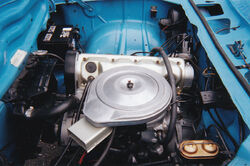
140 CID (2.3 L) 1 bbl. I-4 90 hp
The Vega engine is a 140 CID (139.6 cu in) 2,287 cc inline-4 featuring a die-cast aluminum cylinder block and a cast-iron cylinder head with a single overhead camshaft (SOHC). The cylinder block is an open deck design with siamesed free-standing liner less cylinder bores. Outer case walls form the water jacket and are sealed off by the head and the head gasket. The block has cast iron main caps and a cast iron crankshaft. The cast iron cylinder head was chosen for low cost and structural integrity. The overhead valvetrain is a direct acting design of extreme simplicity. Only three components activate the valve rather than the usual seven of a typical push rod system. The camshaft is supported by five conventional pressed-in bearings and is driven from the crankshaft by an externally mounted continuous cogged belt and sprocket system. Six v-grooves on the outside of the belt drive the water pump and fan. The large bore and long stroke design provide good torque and lower rpm operation for reduced wear. Compression ratio for the standard and optional engine is 8.0:1, as the engine was designed to operate on low-lead and no-lead fuels. A single-barrel carburetor version produces 90 hp. The two-barrel version (RPO L11) produces 110 hp. From 1972 on, ratings were listed as SAE net - 80 & 90 bhp respectively for 1972.
The relatively large (for an inline-4) engine is naturally prone to vibration and is subdued by large rubber engine mounts. The 1972 Rochester DualJet two-barrel carburetor required an air pump for emission certification and was replaced in 1973 with a Holley-built 5210C staged two-barrel carb. Emission control revisions made in 1973 reduced power output on the optional engine by 5 bhp, although the engine's cruising noise levels were reduced. H.E.I. ignition was introduced on 1975 engines. Non-air conditioned cars have a small 12-inch by 12-inch radiator core. The reason for the relatively small radiator was the aluminum engine block and its superior heat conductivity as compared to iron.
Dura-built 140
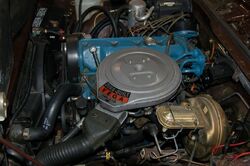
Dura-built 140 CID (2.3 L) 2bbl. I-4 84 hp
The 140 engine was named Dura-Built 140 in 1976. It features improved coolant pathways for the aluminum-block, a redesigned cylinder head incorporating quieter hydraulic valve lifters (replacing the mechanical lifters), longer life valve stem seals, and a redesigned water pump, head gasket, and thermostat. Warranty on the engine was 5 years/60,000-miles.
"August 1, 1975. 8 a.m. Outside the southern edge of Las Vegas, Nevada. Three medium orange Vegas start their engines. They won't be turning them off much during the next 58 days except for rest and food stops, refueling and maintenance. They have a job to do."
Chevrolet conducted an advertised 60,000 miles in 60 days Durability Run of the 1976 Vega and its Dura-built 140 engine. Three new Vega hatchback coupes equipped with manual transmissions and air conditioning were driven non-stop for 60,000 miles in 60 days through the deserts of California and Nevada (Death Valley) using three pre-production models of the subcompact and nine non-professional drivers. All three 1976 Vegas completed a total of 180,000 miles with only one "reliability" incident — a broken timing belt — was recorded. This fact prompted Vega project engineer Bernie Ernest to say, "The Vega has reliability in excess of 60,000 miles, and therefore the corporation feels very comfortable with the warranty." Chevrolet chose the 349-mile Southwestern desert route in order to show the severely criticized engine and cooling system had been improved in the 1976 model.
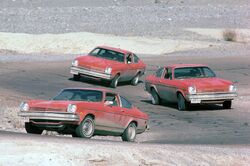
1976 Vegas on the 60,000 miles in 60 days Durability Run
During the 60-day test which was certified and supervised by the United States Auto Club, the three cars were subjected to ambient temperatures never lower than 99 degrees and often reaching as high as 122 degrees. The nine drivers were instructed to treat the cars as they would their own and use the air conditioning as desired. Yet, in more than 180,000 miles of total driving, the cars used only 24 ounces of coolant, an amount attributed to normal evaporation under severe desert conditions. Furthermore, fuel economy for the three test Vegas averaged 28.9 mpg over the duration of the run, while oil was used at the rate of only one quart every 3400 miles. Translated into actual driving expenses, the three Vegas averaged a per-mile cost of 2.17 cents. One of the cars went on display in the 60,000 miles in 60 days exhibit at the 1976 New York International Auto Show. The 1977 Dura-built 140 engine added a pulse-air system to meet the more-strict 1977 U.S. emission standards. The engine paint color went from orange used in '76 to blue as were all 1977 Chevy engines.
122 CID DOHC
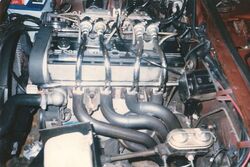
Cosworth Twin-Cam 16-valve, 122 CID (2.0 L) EFI I-4 110 hp
The Cosworth Vega engine is a 122 CID (121.7 cu in) 1,994 cc inline-4 featuring a die cast aluminum alloy cylinder and case assembly and a Type 356 aluminum alloy, 16-valve cylinder head with double overhead camshafts (DOHC) designed in conjunction with Cosworth Engineering of England. The camshafts are held in a removable cam-carrier which also serves as a guide for the valve lifters. Each camshaft is supported by five bearings and is turned by individual cam gears on the front end. The two overhead camshafts are driven, along with the water pump and fan, by a fiberglass cord reinforced neoprene rubber belt, much like the Vega 140 cubic inch engine. Below the cam carrier is a 16-valve cylinder head constructed of an aluminum alloy using sintered iron valve seats. Sturdy forged aluminum pistons and heat-treated forged steel crankshaft and connecting rods reveal racing ancestry; assure high performance durability. The engine features a stainless steel exhaust header and electronic fuel injection (EFI) – a Bendix system with pulse-time manifold injection, four injector valves, an electronic control unit (ECU), five independent sensors and two fuel pumps. Each engine was hand-built and includes a cam cover sticker with the engine builder's signature.
The Cosworth Vega engine is some 60 pounds lighter than the SOHC Vega engine. The engine develops its maximum power at 5,600 rpm and is redlined at 6,500 rpm where the SOHC Vega engine peaks at 4,400 rpm and all is done at 5,000 rpm. Final rating is 110 bhp. 5,000 engines were built, but only 3,508 were used; GM disassembled about 500; the remaining engines were scrapped for a write-off of $10K per engine.
Car and Driver, October 1975 said, "The Cosworth Vega 16-valve four cylinder is the most sophisticated engine Detroit ever made."
Aluminum engine block
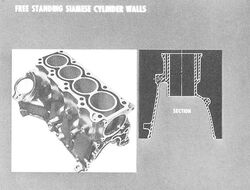
Aluminum block has 17 percent silicon content, free standing siamese cylinder walls
GM Research Labs had been working on a sleeveless aluminum block since the late '50s. The incentive was cost. Engineering out the four-cylinder's block liners would save $8 — a substantial amount of money at the time. Reynolds Metal Co. developed a hypereutectic alloy called A-390, composed of 77 percent aluminum, 17 percent silicon, 4 percent copper, 1 percent iron, and traces of phosphorus, zinc, manganese, and titanium. The A-390 alloy was suitable for faster production diecasting which made the Vega block less expensive to manufacture than other aluminum engines. Sealed Power Corp. developed special chrome-plated piston rings for the engine that were blunted to prevent scuffing. Basic work had been done under Eudell Jackobson of GM engineering, not at Chevrolet. Subsequently, Chevrolet was given job of putting the ohc sleeveless, aluminum block into production.
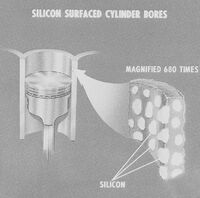
Silicon cylinder bore magnified 680 times
The Vega engine block was cast in Massena, New York - at the same factory that had produced the Corvair engine. Molten aluminum was transported from Reynolds and Alcoa reduction plants to the foundry, inside thermos tank trucks. The block was cast using the Accurad process. The casting process provided a uniform distribution of fine primary silicon particles approximately 0.001 inches in size. Pure silicon provides a hard scuff and wear resistant surface, having a rating of 7 on the mohs scale of hardness, as compared to diamond which is 10. The blocks were aged 8 hours at 450 °F to achieve dimensional stability. Before being shipped to Tonawanda, the blocks were inpregnated with sodium silicate, where they were machined through the outer skin. From Massena, the cast engine blocks were shipped as raw castings to Chevy's engine plant in Tonawanda, New York. Here they underwent the messy etch and machining operations. The cylinder bores were rough and finish-honed conventionally to a 7-microinch finish then etched by a new (then) electro-chemical process. The etching removed approximately 0.00015-inch of aluminum leaving the pure silicon particles prominent to form the bore surface.
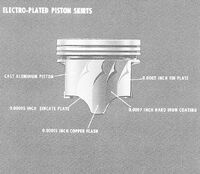
Four-layer electro-plated piston skirts
The technical breakthroughs of the block lay in the die-casting method used to produce it, and in the silicon alloying which provided a compatible bore surface without liners. With a machined weight of 36 pounds, the block weighed 51 pounds less than the cast-iron block in the Chevy II 153 CID inline-4. Plating the piston skirts was necessary to put a hard iron skirt surface opposite the silicon of the block to prevent scuffing. The plating was a four layer electo-plating process. The first plate was a flash of zinc followed by a very thin flash of copper. The third and primary coating was hard iron, 0.0007-inch thick. The final layer was a flash of tin. The zinc and copper were necessary to adhere the iron while the tin prevented corrosion before assembly of the piston into the engine. Piston plating was done on a 46 operation automatic line. From Tonawanda, the engines went to the Chevrolet assembly plant in Lordstown, Ohio.
Eudell Jackobson of GM engineering pointed out one of the early problems with unexplained scuffing and discovered excessive pressure on the bore hones was causing the silicon to crack. He said: "We were trying to put a product into production and learning the technology simultaneously. And the pressure becomes very, very great when that happens. The hone-pressure problem was solved before engines actually went out the door, affecting only pre-production engines."
Engine output summary
| Year | Standard Engine | Optional L-11 Engine & GT (Z29) | Cosworth Twin-Cam (ZO9) |
|---|---|---|---|
| 1971 | 90 hp @ 4,400 rpm136 lbft of torque @ 2,400 rpm | 110 hp @ 4,800 rpm138 lbft of torque @ 3,200 rpm | |
| 1972 | 80 hp @ 4,400 rpm121 lbft of torque @ 2,400 rpm | 90 hp @ 4,800 rpm121 lbft of torque @ 2,800 rpm | |
| 1973 | 72 hp @ 4,400 rpm100 lbft of torque @ 2,000 rpm | 85 hp @ 4,800 rpm115 lbft of torque @ 2,400 rpm | |
| 1974 | 75 hp @ 4,400 rpm115 lbft of torque @ 2,400 rpm | 85 hp @ 4,400 rpm122 lbft of torque @ 2,400 rpm | |
| 1975 | 78 hp @ 4,200 rpm120 lbft of torque @ 2,000 rpm | 87 hp @ 4,400 rpm122 lbft of torque @ 2,800 rpm | 110 hp @ 5,600 rpm107 lbft of torque @ 4,800 rpm |
| 1976 | 70 hp @ 4,200 rpm120 lbft of torque @ 2,000 rpm | 84 hp @ 4,400 rpm122 lbft of torque @ 2,800 rpm | 110 hp @ 5,600 rpm107 lbft of torque @ 4,800 rpm |
| 1977 | 84 hp @ 4,400 rpm122 lbft of torque @ 2,800 rpm |
notes: 1972–1977 hp / torque ratings are SAE Net. L-11 engine standard on 1977 models
Stillborn engines
OHC L-10
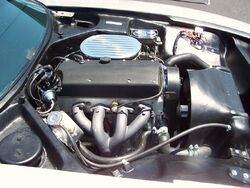
XP-898 concept prototype Vega L-10 engine with "crossflow" aluminum head
Although the optional L-11 engine became a mainstream part of the Vega development program in December 1968, the Chevrolet engine group had an intense dislike for the tall iron cylinder head with its unusual tappet arrangement and side-flow "Heron" combustion chamber design that had been thrust on them from GM engineering staff, and set out to design their own.
The design evolved rapidly as a "crossflow" aluminum cylinder head with a single centrally-mounted overhead camshaft (OHC) and roller rocker arms operating intake valves on one side and exhaust valves on the other, remarkably similar to the Ferrari V12 cylinder head design of that period; it was almost 4" lower than the Vega production head, was a lot lighter, had true "hemi" chambers with big valves, and made excellent power. Numerous prototypes were built, and manufacturing tooling was started in anticipation of approval for production. The real story never came out, but some combination of corporate politics ("You don’t need another cylinder head – mine will work just fine") and additional program investment killed the program. Had it gone to production, it would not have had the differential expansion head gasket problems that plagued the iron-head engine, and would have provided significantly higher performance than the optional L-11 engine.
Rotary Engine
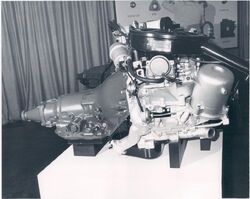
206 cu in GM Wankel engine
photo dated May 25, 1973
In November 1970, GM paid $50 million for initial licenses to produce the Wankel rotary engine, and GM President Ed Cole projected its release in three years, initially targeted for an October 1973 introduction as a 1974 Vega option.
Popular Science magazine in a May 1972 article stated, according to GM, the Wankel had so far proven more reliable than four, six, and eight-cylinder engines — GM-rotary engines were run up to 500,000 miles showing only minimal wear, and the engine's fewer moving parts assured its reliability. The final design General Motors Rotary Combustion Engine (GMRCE) was fixed when responsibility for the power plant's manufacture was turned over to General Motors Hydra Matic Division in August 1972 – two rotors displacing 206 cubic inches, twin distributors and coils, and a switch to aluminum housing construction. Iron couldn't match the heat-dissipating qualities of aluminum. In addition, there was also a rotor tip-seal problem in the cast-iron configuration, especially after 15,000 miles. GM RC2-206 Wankel engines were installed in 1973 Vegas for cold weather testing performed in Canada,
Motor Trend, in a 1973 article "The '75 Vega Rotary" said: "GM saw the rotary engine's future as probably much greater than they do today...mileage will be in the 16-18 mpg range. Compared to the normal piston (engine) Vega's 20 to 26 mpg, the whole rotary deal begins to look just a little less attractive, with what the price of gasoline skyrocketing, but that's another matter." Unwilling to face fuel efficiency criticism that Mazda withstood, GM felt it could meet 1975 emissions standards with the engine tuned to provide better mileage. Other refinements improved mileage to 20 mpg, but with the fuel breakthrough came related side-effect problems —apex seal failures, as well as a rotor tip-seal problem.
By December 1973, it was clear the Wankel, now planned for the Monza 2+2, would not be ready for either production or emissions certification in time for the start of the 1975 model year, and after paying another $10 million against its rotary license fees, the company announced the first postponement. Motor Trend in April 1974 predicted the final outcome – on September 24, 1974, Ed Cole postponed the Wankel engine ostensibly due to emissions difficulties. He retired the same month. GM admitted fuel economy for the rotary was sub-standard and postponed production in favor of further development. Pete Estes succeeded Ed Cole as GM President and never showed any special interest in the Wankel or in the perpetuation of Cole's ideas. Estes had previously decided to let the Corvair, another Cole project expire months before the celebrated attacks of Ralph Nader.
Production
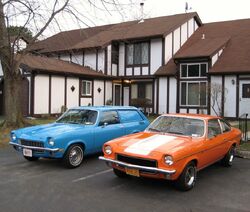
1971 Vega Panel Express
Panels were only 1% of Vega production.
1973 Vega GT-Millionth Vega special edition 6,500 built May thru July 1973
Total Vega production was 2,010,547 including 3,508 Cosworth Vegas. The majority were built in the United States at Lordstown Assembly in Lordstown, Ohio. Vega production at Lordstown was projected at 100 cars an hour from the beginning: one vehicle every 36 seconds. This was nearly twice the normal volume and by far the fastest rate in the world. At its peak, production was 2,400 units per day. Vegas were also built in 1973-'74 at the GM of Canada plant, Sainte-Thérèse Assembly, Quebec. Collectible Automobile in April 2000 said, "One thing that helped the Vega sell was its timing. The car came out for the 1971 model year. In late 1973, the first big international fuel crunch hit, with small, thrifty, American-made cars suddenly in great demand. The 1973-'74 Oil embargo, perhaps more than any other factor, boosted the Vega's fortunes."
| Year | Notchback | Hatchback | Kammback | Panel Del. | Cosworth | Total |
|---|---|---|---|---|---|---|
| 1971 | 58,804 | 168,308 | 42,793 | 7,800 | — | 277,705 |
| 1972 | 55,839 | 262,682 | 71,957 | 4,114 | — | 394,592 |
| 1973 | 58,425 | 266,124 | 102,751 | 3,886 | — | 431,186 |
| 1974 | 64,720 | 276,028 | 115,337 | 4,289 | — | 460,374 |
| 1975 | 35,133 | 112,912 | 56,133 | 1,525 | 2,061 | 207,764 |
| 1976 | 27,619 | 77,409 | 54,049 | — | 1,447 | 160,524 |
| 1977 | 12,365 | 37,395 | 25,181 | — | — | 78,402 |
| 2,010,547 |
Pricing
Due mostly to inflation, but also because of emissions and safety mandates, prices of all automobiles rose 50 percent during the Vega's seven-year lifespan. The same basic Vega that cost $2090 in 1971 carried a retail price of $3249 by 1977. Since all other cars suffered the same inflationary rise, less expensive cars were in greater demand than those with higher prices which helped Vegas sell. The 1975 Cosworth Vega at $5,918 was priced $892 below the Corvette. "Cosworth. One Vega for the price of two" as it was advertised was Chevrolet's most expensive passenger car, falling short of its projected sales goal.
| 1971-77 Vega | ||||||
|---|---|---|---|---|---|---|
| 1971 | 1972 | 1973 | 1974 | 1975 | 1976 | 1977 |
| MSRP-base price | ||||||
| $2090–$2328 | $2060–$2285 | $2087–$2323 | $2505–$2976 | $2786–$3244 | $2984–$3450 | $3249–$3745 |
| 1975-76 Cosworth Vega | ||||||
|---|---|---|---|---|---|---|
| 1975 | 1976 | |||||
| MSRP-base price | ||||||
| $5918 | $6066 | |||||
Review
Motor Trend August 1970, Vega 2300 — Chevrolet's fantastic new mini: the point to which all things are coming.— John DeLorean, GM vice president and Chevrolet general manager discussed the car, touting its quality of assembly and its handling capabilities. DeLorean said, "Our design concept was we wanted to build a car that does everything well, and if you drive the car you really will be very impressed. It has far and away the best handling of anything in its class. In fact it handles better than many sports cars. The performance is excellent. It out-performs any car in its price class in accelerating. There is nothing that comes within a mile of the Vega for performance and handling. This car will out-handle almost any sports car built in Europe. Not just little cars, but sports cars too. This is quite an automobile." "The Vega is going to be built at a quality level that has never been attained before in a manufacturing operation in this country, and probably in the world. For example in our body construction, on a typical car, built either here or Europe or Japan, about 18 percent of the body welds are automated. On this car over 80 percent are automated so you eliminate the worker carrying a heavy welding gun around. It reduces the work effort involved and provides uniform quality. We have automatic inspection of virtually every single engine part and so we know it's going to be right." " It has a high degree of craftsmanship...I think the ride and handling of some of the imports is quite mediocre. As I said earlier, the Vega has good craftsmanship, without the faults of the imports."
Chevrolet's mini hits the road and we are there—MT editor Bill Sanders said, "The Vega 2300 is Chevrolet's answer to Volkswagen, Datsun, Toyota, Fiat, Renault, and all others up the ladder. Like any car, the Vega has its good points and bad. After 2 days of hard driving over the mountains, across the high desert at 5,000 feet through Navajo and Hopi country and down into the 110-degree heat of Phoenix and the GM desert proving grounds, we had had about enough....In our 2-day stint the Vegas performed aptly, with only minor problems that could be ironed out before full production began." "Inside all three Vegas we were impressed with the comfort. High-back bucket seats are standard, there's nary a bench seat seat in sight... The deluxe seats in the GT car are extraordinarily comfortable. Comfort and ride are all tied up together, consequently much of the comfort is a reflection of superb ride qualities." "Many hours of wind tunnel testing experimentation created good aerodynamics, which in turn manufactures good road holding capacity. The net result is a car in the 2,200-pound range that rides like a car weighing twice as much." "From a styling standpoint, it is a winner... As a total concept, the car looks like it will be a winner because of several factors. Price should be one..." "The wagon is roomy and sporty looking. The GT coupe is sporty, something most American compacts that have ever existed weren't."
In a road test of the basic sedan, MT editor Jim Brokaw said, "The low dollar Vega is a complete automobile. It requires nothing more to be an enjoyable, functional piece of transportation...It's readily apparent from the overall impression of the car that some very basic concepts of driver and passenger comfort have been built in from the ground up, with efficient flow-through ventilation being the most noticeable on the desert. Styling is well-balanced with some very distinct traces of the Camaro, including the grill." "Unlike the import competition, seating is low and comfortable. The Vega seating placement and design permits a feeling of sitting down inside the vehicle, surrounded by warm, reassuring Detroit steel." "The Vega will get you there without generating any unscheduled stops;" "While there is sufficient power available to negotiate traffic and most hill climbing requirements, the 90 horses under the hood are pretty much out of it above 55 mph when it comes to any rapid passing," "Handling on the road is a slick compromise between a very comfortable ride and the necessity of keeping it all on your assigned strip of pavement.
In a road test of the GT coupe, MT editor Bill Sanders said, "The Vega GT with a 19 sec. quarter mile e.t. doesn't rattle any splines. But forget it if that's all you want. Even at 19 seconds the GT fills you with as much adrenaline as some of its faster big brothers." "GT coupe is a jewel—whether going flat out or through the corners." "In normal driving, with curves of the type you'll find on mountain highways, the car has a refreshing neutral steering that escapes beautifully from the normal understeer rut found in many compacts. It is so pleasant you begin to feel the togetherness with the car...Some cars get a little scary the faster you push them; this one is just the opposite, the handling improves. Everything is always pressed down flat in the corners, there's no roll steer of any kind, tied in with car's refreshing neutral steering give the GT some exciting handling characteristics;" "Normal braking is smooth, straight and usually fade resistant." "In summary the Vega GT comes close to what a racing GT car should be, in handling, performance and comfort. Because it's basically a low-priced compact, the results are all the more surprising and rewarding."
In a road test of the wagon, MT editor Jim Brokaw said, "Just as in the base sedan and the GT coupe, the key word is comfort. The front bucket seats accommodate two adults very graciously with little difficulty getting in or out...Back seat room in the wagon is restricted but livable." Handling on the highway is a pleasant surprise. The wagon's moderate understeer is easily compensated by quick steering and once a line is established through a turn, the car follows quite politely. As in the base sedan, the roll rate is constant and does not generate any last minute surprises in the turn. Handling on the track is quite another story though. Understeer is much more pronounced negotiating 90 degree turns under maximum conditions." "In spite of the understeer, for a wagon the handling is quite good." "Normal stopping is very unexciting but the panic version from 60 mph produces wheel hop. Not as violent as the coupe, but disconcerting." "Under normal driving conditions, the wagon is well behaved and takes you where you want to go with a minimum of fuss and maximum comfort." "All in all, the Vega is a most versatile machine that gets the job done where its needed: driving to and from work, shopping, school, and the beach, depending on your sex and occupation."
See all Chevrolet Vega Reviews
Awards & Accolades
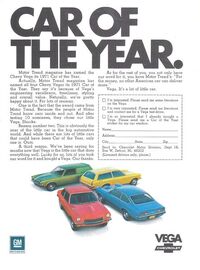
1971 Chevrolet Vega advertisement
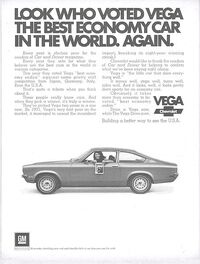
1972 Chevrolet Vega advertisement
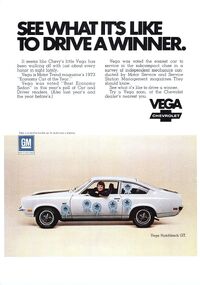
1973 Chevrolet Vega advertisement
The Vega was popular with the automotive press, winning awards and praise for its innovative engineering, timeless styling, and sports car-like handling. Chevrolet's advertising for the Vega included ads promoting awards won by the car. Motor Trend Classic, in the Fall 2010 issue said, "Chevrolet spun the Vega as a more American, upscale car. And let's face it, the car looked hot. So can you blame us for falling hook, line, and sinker for the Vega and naming it 1971's Car of the Year?"
Road and Track editor John R. Bond praised the Vega in a 1970 "Technical Analysis & Driving Impression" saying, "I think the Vega is beyond a doubt the best handling passenger car ever built in the U.S. It has many other good qualities, but the roadholding impressed and surprised me most of all."
Motor Trend awarded the Vega 1971 Car of the Year.
MT: "The base Vega is a magnificent automobile without any options at all." "...It is appropriate that the final choice was a car that reflects Detroit's timely response to the people's needs instead of a copy writer's idea of what they should need. So, the Chevrolet Vega 2300 is Motor Trend's 1971 Car of the Year by way of engineering excellence, packaging, styling and timeliness. As such, we are saying that for the money, no other American car can deliver more."
Car and Driver readers voted the Vega Best Economy Sedan in 1971, 1972 and 1973 in C&D's Annual Reader's Choice Poll.
C&D: "In 1971, the Vega's first year on the market, it managed to unseat the incumbent import, breaking its eight year winning streak."
American Iron and Steel Institute awarded the Vega in 1971 for–Excellence in design in transportation equipment.
Service Station Management and Motor Service magazines in a 1972 survey, the Vega was voted –"Easiest to service, least mechanical problems and best overall in its class" by independent servicemen.
Motor Trend nominated the 1971 Chevrolet Vega to the "Motor Trend Hall of Fame" announced in 1973. Motor Trend's 21 Car of the Year selections—1949-1973 were nominated.
Motor Trend awarded the Vega GT 1973 Economy Car of the Year.
MT: "The best version of the Vega came out on top matched against the best versions of its competition."..."The Vega was judged solid, warm and comfortable, with a good finish." Pleasing the American car buyer is a delicate task. Economy really means economy with an illusion of luxury. This time Chevrolet won the guessing game."
Car and Driver selected the '76 Cosworth Vega one of the "10 Best Collectable Cars" (1976-1986) in its fourth annual "Ten Best" issue in 1986, saying: "We're talking about historical significance here."
Super Chevy magazine included the 1975-'76 Cosworth Vega in their 2011 list of the "100 Most Significant Chevys Of All Time."
Criticism & Response
Chevrolet paid a price in its rush to introduce the Vega with the other 1971 models. Chevrolet's "bright star" received an enduring black eye despite a continuing development program which eventually alleviated most of its initial shortcomings. Further development and upgrades continued throughout the car's seven year production run, addressing its engine and cost-related issues. Motor Trend Classic editor Frank Markus said in 2013, "Overblown. The China Syndrome might have overhyped the TMI (Three-Mile Island) incident as bad press might have exaggerated the Vega's woes.
Recalls
Early Vegas had a few designed-in flaws, most minor, but an ill-fitting gas cap, ineffective windshield wipers, and a faulty choke drew fire from perennial GM foe Ralph Nader. 23,000 cars built before the Sept 15, 1970 UAW strike were recalled April 3, 1971.
- April 5, 1972 – The first of three major recall campaigns early in the Vega's production run got underway. 129,000 potential Vegas equipped with engine option L-11 (two-barrel carburetor) could experience exhaust system backfires of sufficient frequency and magnitude to weaken and rupture muffler. Exhaust from muffler with ruptured end cover could subject fuel tank to sufficient heat to expand fuel and create fuel spillage. Subsequent engine backfires may ignite fuel and cause fire damage. (correct by inspecting and installing new muffler and components where necessary.)
- May 8, 1972 – 350,000 potential Vegas equipped with standard engine and monojet (single-barrel) carburetor could experience breakage of idle stop solenoid bracket. Should bracket break, there was a possibility that idle solenoid and clamp portion of bracket could drop and lodge in area that could cause throttle to be held in partially open position. (corrected by installing additional new bracket.)
- July 5, 1972 – 526,000 potential Vegas were recalled for possibility that rear axle shaft may have insufficient thrust button length. Could permit excessive end play and allow axle shaft to move inboard to point that "c" lock would disengage. Axle shaft and wheel could then move outboard of quarter panel and allow vehicle to dropdown onto rear suspension. (corrected by inspecting and replacing axle where necessary.)
140 CID engine
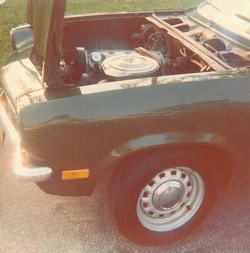
1972 Vega Kammback Wagon, L-11
140 CID I-4, Rochester 2-bbl. carburetor
The liner less aluminum block has been blamed for a large share of the Vega's tarnished reputation. An iron engine could survive moderate overheating, but the Vega could not. A simple fix eliminated the problem but not before the car's reputation was nearly destroyed. The engine itself was reliable by design, with fewer moving parts than pushrod engines.
Motor Trend September 1974, editor John Lamm said, "Incidentily, because present problems with overheating and warpage of the Vega engines have been caused driving around with too little coolant, all Vegas will have an instrument panel light warning when coolant is down one quart."
Although non-a/c cars held only 6 quarts and had a tiny two-tube, 12"x12" radiator, when topped off the cooling system was adequate. But most owners tended not to check the coolant level often enough, and in combination with leaking valve-stem seals the engine would often be low on oil and coolant simultaneously. This caused overheating which distorted the open deck block allowing antifreeze to seep past the head gasket, causing piston scuffing inside the cylinders. In response, Chevrolet added a coolant overflow bottle and an electronic low-coolant indicator in 1974 that could be retrofitted to models at no cost. In May 1974 under a revised 50,000 mi engine warranty for 1971–1975 Vegas, Chevrolet informed the 1.3 million owners that it would repair, at its own expense, any engines damaged by overheating. An owner with a damaged engine had a choice to have the short block replaced with a brand new GM unit or a remanufactured, aftermarket steel-sleeved unit. This proved costly for Chevrolet.
"IMHO much of the cavitation corrosion that created the need for flanged sleeves that replaced the entire sealing surface at the deck were caused by misinformed owners who recklessly removed and plugged all the vacuum hoses in the belief that they were disabling the emissions controls. In reality they were giving the ignition too much advance and often leaning it out too much, creating damaging detonation. Also, GM specified an unusually tight piston to wall clearance, likely because of the similar rate of thermal expansion between the piston and wall. Unfortunately, too many owners wouldn't warm them properly before loading the engine enough to get the piston hot and expand it while the cylinder was still surrounded by coolant that was at a lower temperature. That would scuff the pistons prematurely." Tom Mooty, Motorology (Facebook)
Eudell Jackobson from GM engineering confirmed the problem involving the engine's valve-stem seals: "After the engine had been in production for a while, customers would go back to the dealer complaining about oil consumption... the mechanic would peer down the bore scope and observe cylinder scuffing. We eventually found out that the problem had never been the scuffing of the (cylinder) bore. The real problem was the valve stem seals. They'd harden, split, fall off, and oil would leak down past the valves and into the combustion chamber. So we did some experiments. When we got an oil burner, we simply replaced the valve-stem seals, and that cured it."
1976-'77 Dura-built engines had redesigned seals that reduced oil consumption by fifty percent.
GM engineer Fred Kneisler maintaines that too much emphasis had been put on overheating problems versus the real culprits: brittle valve stem seals and too-thin piston plating. Regardless of the cause, damaged cylinder walls were common. Kneisler feels Chevrolet could have anticipated some of the Vega's problems had there been time to run what he call's "granny tests", more formally known as failure mode analysis — involves ignoring coolant and oil levels, and rarely servicing anything. The granny test would have taken time, which the Vega's development engineers didn't really have. But apparently no one thought to run granny tests anyway. Kneisler confessed, "It astonishes me that not one of us thought about seeing what would happen if we ran out of water. And the test system back then didn't let things fail. If a test driver at the proving grounds didn't ever check one of those engines and let it run out of coolant...if it burned up, he'd get fired. The drivers were checking coolant every day, checking the oil, checking everything every shift."
1976-'77 Dura-Built 140 engines had improved engine block coolant pathways, longer life valve stem seals, redesigned head gasket, water pump, and thermostat, and a five-year/60,000 mi warranty.
Despite its lack of success with the Vega, the liner-less aluminum/silicon engine technology that GM and Reynolds developed turned out to be sound. Mercedes-Benz and Porsche both use sleeveless aluminum engines today, the basic principles of which were developed for the Vega engine.
Fisher Body
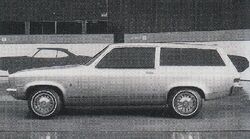
XP-887 Wagon, September 1968
Jerry L Brockstein, assistant to Henry Haga, head of the Camaro/Corvette studio where the Vega prototype was restyled, recalls finalizing the Vega bodies. Brockstein said: "Chevrolet was trying to build this car as cheaply as possible and wanted us to take a lot of money out of it. At first the metal was so thin on the Kammback wagon that in the test facilty it kept buckling under its own weight. Fisher Body had to come back and put stiffing ribs in the roof. Note, though, that Fisher often under-engineered prototype bodies because it was easier and more economical to reinforce a weak body than to shave one that had more strength than needed.
Chevrolet, in a January 1971 Vega engineering report stated early difficulties were experienced at the front and rear suspension attaching points. Using scaled suspension members to impose static loads, stress evaluations were conducted. It was determined that addition of reinforcements, metal gauge increases, and some redesign of the pieces would give desired structure.
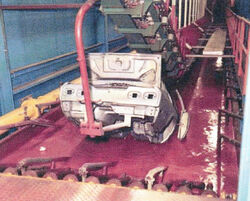
Fisher Body Vega Elpo Dip
Fisher Body Division was very proud of its Elpo primering process, which should have prevented rust, but didn't. The Elpo process pioneered by Fisher followed a seven stage zinc phosphate initial treatment and itself involved submerging the assembled Vega body in a vat containing reddish-brown paint-primer particles in 65,000 galllons of water. The metal body received a positive electrical charge, the primer particles carried a negative charge, and by leaving the body in the vat for two minutes even the most remote recesses get coated, theoretically. The body was then dried, wet-sanded, sealer-coated and finally sprayed with acrylic lacquer and baked in a 300 °F degree oven. In practice however, the Elpo dip did not flow to every recess or reach every surface. Vega expert Gary Darian said, "The design of the front end caused air to be trapped at the tops of the fenders, so they never got coated. Early cars had no inner fender liners, so the tops of the front fenders got blasted by sand and salt thrown up by the tires, and they quickly rusted." Derion pointed out, too, that a rust-prone gap existed between the front fenders and the cowl vent. "Moist debris and salt would pack into this area rusting through the metal in a few years."
Chevrolet installed stopgap plastic deflectors in late 1973 and full plastic inner fenders in 1974.
The original design provided for the full inner fender liners from the beginning. But at a cost review meeting the finance department cancelled the liners, as they would have added $1.14 per side, or $2.28 per car to the product cost. One of the program objectives was to produce a 2,000-pound car to sell for $2,000.00, and every penny was watched. Five years later, after GM had spent millions to replace thousands of sets of rusted-out Vega fenders in the field, the plastic fender liners were reinstated as a mid-model change during the 1974 model year. But rust damage also affected the rocker panels, the door bottoms, the area beneath the windshield, and the primary body structure above the rockers. Darian added. "The front suspension cam bolts would sometimes rust solidly in place, which prevented alignment adjustments. To remove the cam bolts required lots of careful work with a cutting torch and all new parts."
Starting in 1976, extensive anti-rust improvements on the Vega's body included galvanized steel fenders and rocker panels and "four layer" fender protection with zinc coated and primed inner fenders and wheelwell protective mastic, zinc-rich pre-prime coating on inner doors, expandable sealer installed between rear quarter panel and wheel housing panel, and corrosion resistant header panel, grill and headlamp housings.
Yenko Stinger II
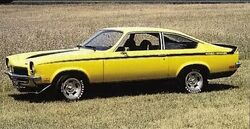
1971 Yenko Stinger II
The Yenko Stinger II was marketed by Yenko Chevrolet of Canonsburg, Pennsylvania through 1973— based on the Vega GT, Yenko added anti-hop traction bars, front and rear spoilers, Yenko Stinger II side striping, black out paint accents and "Yenko identification nameplates on fenders and rear end panel. A turbocharger kit was available separately for the Vega's 140 cu in engine. Road & Track April 1971 said, "A turbo-charger and other good things transform the Vega into a sports car. Even the SCCA says so."
By the end of 1970, ever-increasing insurance rates put a stranglehold on the once-flourishing muscle car market, and it was clear to Don Yenko that Chevrolet was planning to stop offering high horsepower engines for their cars and would begin producing small cars for this new, burgeoning market. The all-new Vega was powered by a four-cylinder engine, but what could Yenko undertake and keep his performance legacy alive while retaining the Vega's four-cylinder engine to appease the insurance companies. His Vega Stinger II was the answer. But the Feds intervened; The EPA informed him that the 155-hp Turbo Vega would need to pass EPA certification before it could be sold to the public. The certification process required a 50,000-mile test. Yenko had his staff rent a racetrack but at the last minute, he decided not to go through with the testing. He did however sell Yenko Vegas, albeit, the turbocharger would not be part of the package, but available separately as an aftermarket item. Chevrolet did build Yenko's engines with special forged pistons for added durability for the turbo application. 400 1971-'72 COPO Yenko Stinger Vegas were sold (350 '71/'72 hatchbacks; 50 '72 wagons). There are very few documented examples surviving today.
Rebadged variants
Vega body styles were used to produce several rebadged variants. 1973–1977 Pontiac Astres used all Vega bodies (and Vega I-4 engines) 1977 Astre hatchbacks and wagons used an I-4 engine supplied by Pontiac. 1978–1979 Chevy Monza and Pontiac Sunbird wagons used the Vega Kammback wagon body with I-4 and V6 engines supplied by Pontiac and Buick. Chevy also offered the Monza 'S' for 1978, using the Vega hatchback body and the I-4 engine supplied by Pontiac.
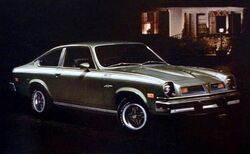
1975 Astre GT Hatchback Coupe
The Pontiac Astre was introduced in the U.S. for the 1975 model year giving Pontiac dealers a needed fuel efficient subcompact. Pontiac's trademark split grill and front emblem, Astre nameplates, an upgraded interior trim and a Pontiac steering wheel with emblem helped to differentiate itself from the Vega. The SJ Hatchback and SJ Safari Wagon models feature soft nylon upholstery, cut pile carpeting, padded and cloth covered door panels, and a fabric headliner, plus rally instruments, the higher-output two barrel engine, four-speed (over a three-speed manual) gearbox or automatic and radial tires. A GT package option for the hatchback and Safari wagon combined the lower-line interior with the SJ's performance and handling features. 3,000 1975 "Lil Wide Track" packages were sold. The package includes a front air dam, rear spoiler, appliance wire mag rims, window louvers, a chrome exhaust tip, and bright stripe decals for the hood, body sides, rear spoiler, door handles, and wheel centers. 1977 models featured a new vertical design grill and aluminum wheels were a new option. The Astre Formula was introduced which included the handling package, chrome valve cover, three-piece spoiler, Formula T/A steering wheel and special decals. The Astre used the Vega 140 CID (2.3 L) OHC engine. In 1977, The Pontiac 151 CID (2.5 L) OHV "Iron-Duke" inline-four engine was standard in hatchbacks and wagons (optional for the notchback). Transmissions were the three- and four-speed manual, five-speed manual with overdrive (1976–1977 option) and the three-speed automatic.
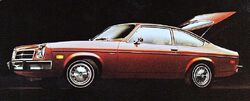
1978 Monza 'S' Hatchback Coupe
The Chevrolet Monza 'S' produced for the 1978 model year used the Vega hatchback body style. With the Vega nameplate canceled, the Monza 'S' was marketed as the price leader hatchback for the Chevy Monza line. The rebadged Vega had the new Monza front end header panel and grill with Chevy bowtie emblem, steel front and rear bumpers replaced the Vega's aluminum bumpers. Monza front fender nameplates, and a two-spoke color keyed steering wheel with Monza emblem. White-wall tires and full wheel covers were standard as were bumper rub strips. Pontiac's 151 CID OHV 'Iron-Duke' in-line 4 was standard. 196 CID and 230 CID V6 engines were optional. The four-speed manual were standard with all engines. The five-speed manual with overdrive and three-speed automatic transmissions were optional.
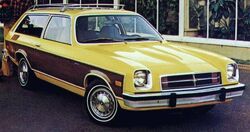
1978 Monza Estate Wagon
The Chevrolet Monza Wagon produced for the 1978–1979 model years used the Vega wagon body style. The rebadged wagon had a Monza front end and grill, new front and rear steel bumpers, front fender nameplates and the Monza steering wheel with emblem. White-wall tires, full wheel covers and bumper rub strips were standard equipment. The Monza Estate, like the Vega Estate wagon it replaced, featured wood grain side and rear trim with outline moldings and the custom interior. Monza wagon models included, as standard, the 151 cu in I-4. 196 CID and 230 CID V6 engines were optional. The four-speed manual was standard with all engines. The five-speed manual with overdrive, and three-speed automatic transmissions optional.
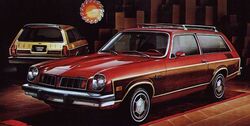
1978 Sunbird Safari Wagons
The Pontiac Sunbird Safari Wagon produced for the 1978–1979 model years used the Vega wagon body style. It replaced the discontinued Pontiac Astre Safari wagon which was essentially carried over with Sunbird badging. The Sunbird wagon retained the Vega/Astre aluminum bumpers, unlike the Monza wagon, which featured a new front end and steel bumpers, but the 1979 model featured a revised horizontal styled grill. Standard powertrain was Pontiac's 151 cubic inch inline-four with a four-speed manual transmission. Previously unavailable for the Astre was the Sunbird's optional 196 CID and 230 CID V6 engines. Five-speed manual and three-speed automatic were transmission options.
| Rebadged variant | Production |
|---|---|
| 1975–1977 Pontiac Astre | 147,773 |
| 1978 Chevrolet Monza 'S' Hatchback | 2,326 |
| 1978–1979 Chevrolet Monza Wagon | 41,023 |
| 1978–1979 Pontiac Sunbird Wagon | 11,336 |
| Total | 192,458 |
note: 1973–1974 Pontiac Astre (GM of Canada) N/A
XP-898 Concept
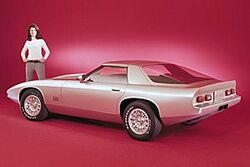
XP-898 Concept car
The Chevrolet XP-898 concept car is a front engine, rear wheel drive design based on the Chevrolet Vega using many of its components including the aluminum-block 140 cubic inch inline-four engine but with a "stillborn" Chevrolet prototype crossflow aluminum cylinder head with single centrally-mounted overhead camshaft (OHC) and roller rocker arms operating intake valves on one side and exhaust valves on the other, remarkably similar to the Ferrari V12 cylinder head design of that period; The vehicle has a 90 inch wheelbase with an overall length of 166 inches. This two-seater sports coupe offered a unique look at alternative engineering approaches to future techniques in design and manufacturing.
The vehicle was built with a frameless fiberglass foam sandwich body and chassis. The entire body consists of four lightweight fiberglass outer body panels, the floor pan, firewall, upper front, and upper rear with a rigid urethane foam filling the designed clearance between the panels. The structure and appearance of the car were designed so that the body could be assembled using four lightweight molded outer skin sections. With the outer skin panels placed in a foaming mold, liquid urethane was injected between the panels where it expanded and bonded the body into a single, rigid sandwich structure. The result was a vehicle body virtually free of squeaks, rattles, and vibrations. Once the urethane hardened (which took about fifteen minutes), the suspension, drive train, hood and doors were bolted to reinforcing plates, which were bonded to the fiberglass panels. A key consideration in the engineering design of the XP-898 was the advantage of improved crash worthiness of the sandwich construction technique. The energy absorption characteristics of the vehicle enabled engineers to simulate crash conditions for the vehicle at speeds up to 50 mph without catastrophic failure to the structure.
See also
- Chevrolet Vega Reviews
- Chevrolet Cosworth Vega
- Millionth Vega
- Car and Driver's SS/Sedan Challenge 1973 Vega GT
- Lordstown Assembly
- Vert-A-Pac
- DeLorean Factor
